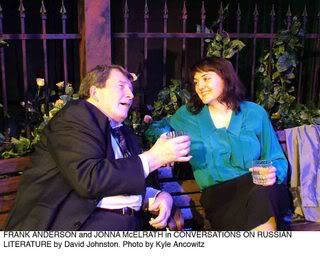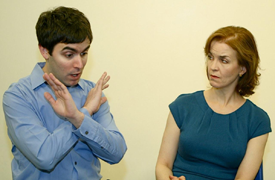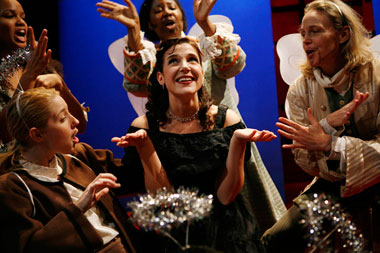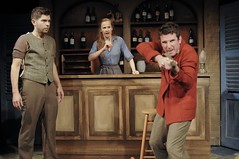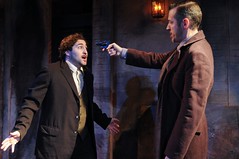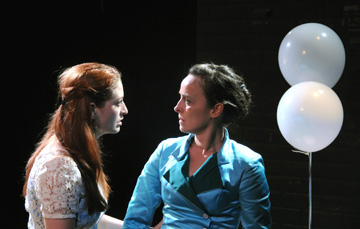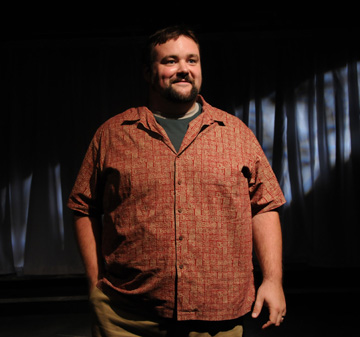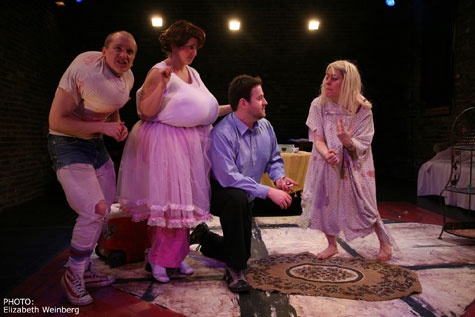Two Figaros for one low off-off-Broadway price — sounds like a good deal, right? Playwright Eric Overmyer adapted and concatenated Beaumarchais' original Marriage of Figaro (the play on which the famous Mozart opera is based) and a rather dark 20th century sequel, Figaro Gets a Divorce, into one extended Figar-anza — with music. It's a long night, an exercise in extremes, and an interesting concept. Unfortunately, half is also an ordeal.
In the 1930s, the German-language playwright Ödön von Horváth wrote a time-transposed sequel to The Marriage of Figaro. In Figaro Gets a Divorce, the Count, the Countess, the steward Figaro, and his wife Susanna have fled a 20th century Communist revolution into an efficiently run, unnamed but Germanic-style neighboring country. While the fallen Count enters a downward spiral of gambling and depression, Figaro returns to barbering in a small town. But marital issues and conflicting ideals push the barber and Susanna apart, and she ends up alone, waitressing in a cafe.
Transporting Beaumarchais' colorful characters, who are more emblematic than realistic, into a modern, bourgeois, somber-hued world, exploring what happens to the fallen nobility, and examining how the various servant characters at home and abroad might retain or transfer their loyalties is an interesting idea. But either von Horváth's play is very bad, or it has been adapted very badly.
Knowing a bit of Eric Overmyer's work, and judging from the high quality of his adaptation of the Marriage, which forms the first act of this production, I suspect the fault to lie with von Horváth's original work. (I was not familiar with it prior to this production.) Once the characters are situated in their new universe and some parameters are established, the story, such as it is, flies every which way. Each scene seems a disconnected vignette, and we quickly cease to care about those once-lovable characters. The political philosophy that gets poured on doesn't make up for it; it's facile and not effectively dramatized. On top of all that, inexpertly played music and some goofy costume choices make a poorly conceived work seem poorly executed as well.
That's a pity, because, with nimble help from director Erin Smiley, Mr. Overmyer begins the evening with a clever, cheery, mostly well-played, compressed telling of the original late 18th century play, adorned with musical themes from Mozart's famous opera. The music comes from supporting cast members who double on an assortment of instruments, marching in and out, annoying the main characters — it's silly but quite funny.
More important, the leads are solid. Teddy Alvaro makes a witty and energetic (if a little too modern-ironic) Figaro, Ralph Petrarca a wry and funny Count Almaviva, and Kathryn Elisabeth Lawson a spry and winsome Cherubino. Gillian Wiggin's Susanna is especially delightful; in this telling she bears the greatest dramatic weight, along with her share of the comic, and does it wonderfully well. She alone makes the dreadful second half faintly bearable.
Fortunately, at off-off-Broadway prices, you will get your money's worth just from the first half. It's a minor tour de force of distilled, manic storytelling, expertly directed and nicely played. As for what Stephen King might call the evening's "dark half," enough said.
Through March 22 at the 14th Street Theater, 344 W. 14 St, NYC. Staged by the (re:) Directions Theatre Company. Tickets online or call (212) 868-4444.




